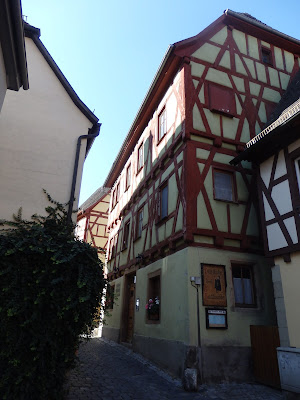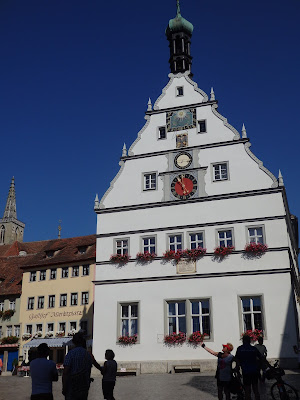 |
| St. Wolfgang's Church (St. Wolfgangskirche) was built by the shepherds of the town for their patron saint. It is actually incorporated into the town's fortifications. |
 |
| As we stood in this spot I watched cars moving in both directions thru this small archway called Klingentor (Klingen Gate). This is an opening in the old town's fortified wall. |
 |
| On the other side of the tower were stairs leading to the top of the wall. We climbed them and looked out over the town. |
 |
| Individuals and other entities are able to buy plaques that are embedded into the old fortified wall. |
 |
| After a short distance, we came back down. |
 |
| Looking back the way towards Klingentor. |
 |
| Click to enlarge for reading. |
 |
| As with many of the old buildings, there's a pulley at the top that was used to lift supplies into the storage area at the top. |
 |
| Buildings were taxed based on the amount of land they occupied so upper stories were often built larger. |
 |
| St Jakobs Kirche |
 |
| A building in the Kirchplatz had and interesting way to put the windows. |
 |
| If you know how to read them, you could tell the time and date. |
 |
| More photo of the exterior of St Jakobs Kirche. |
 |
| Beautiful entrance on the building facing the front of the church |
 |
| Heading into the Parktplatz on Herrngasse |
 |
| Marien-Apotheke, a drug store. |
 |
| Stadt Rothenburg ob der Tauber, Rothenburg City Hall |
 |
| Next we headed off to the Christmas museum. Have you ever heard of Christmas pyramids? |
 |
| Back out on the street I started noticing all the fancy business signs This one is on the pharmacy building in a previous photo. |
 |
| Headed down Obere Schmiedgasse. |
 |
The Plonlein and Siebers Tower.
|
 |
This is the Siebers Tower.
|
 |
| Exterior view of Siebers Tower. |
 |
| Love the "eye" windows on this youth hostel. |
 |
| Once again I'm back out along the fortified wall. |
 |
| The wall looks short on this side but it's quite a drop on the other |
 |
| The Kobolzellertor has an amphitheater at its base.. |
 |
| The wall follows the contour of the land. |
 |
| After lunch I walked around town some more. This house was built in 1270. Read more about it in the next photo. |
 |
| I climbed to the top of the eastern wall thinking I would stay on it all the way around the town. |
 |
| It was real skinny where there were stairs going down. |
 |
| This is how they handle rain running off the roofs when the homes are so close together. |
 |
| I saw these in quite a few place on roof but I don't know what they do. |
 |
| Don't you just love the weaving rooflines? |
 |
| Someone even had a rooster statue |
 |
| Looking down into the back yards. |
 |
| Inside one of the towers. |
 |
| This gable definitely needed work. |
 |
| I also saw these scalloped plastic tiles on the roofs. |
 |
| Spitalbastei. See info on next photo |
 |
| Inside Spitalbastei |
 |
| I descended into the old moat area. |
 |
| Pig's Tower. Read about it in next photo. |
 |
| Plaque on Pig's Tower |
 |
| Pig's Tower entrance. Looks like the opening above the door was for pouring boiling oil or hot pitch on invaders. |
 |
| Into the tower |
 |
| Going up. |
 |
| Lime tower with Reichsstadthalle to right. |
 |
| Inside of Lime Tower |
 |
| Lime Tower is the one with the amphitheater at the base. |
 |
| Plaque in the wall sponsored by New Mexico State University. |
 |
| Why would there be a door in the wall? |
 |
| Looks like we'll take a peek out it. |
 |
| Ah! The garderobe (a lavatory in a medieval building) if that's what they call it in a medieval fortress wall. |
 |
| View from the An Der Eich Look Out Point shows the towers of St Jakobs Kirche in the distance |
 |
| Defensive wall moved down to another level and Kobelzellertor is the next tower. |
 |
 |
| Notice the bottles hanging on the wall? |
 |
| These are bocksbeutel bottles, a design used in this area that is used for the best wines from the city's own winery. |
 |
| This house is built right into the wall. |
 |
| Saw a lot of wind turbines on the way back to Wurzburg. |
 |
| Three busloads went to Rothenburg. |
 |
| I recognize the corn but I don't know what the other crop is. |
 |
| Can't get a good photo as we fly by. Maybe beets? Sugar beets? |
 |
| Price per liter for fuel. So 3.79 x 1.269 = 4.81 euro at today's rate = $5.27 per gallon. So quit complaining about the price of gas. |
 |
| Vineyards growing straight up the hillside. |
 |
| Back in Wurzburg. |
 |
| Statue outside the cathedral |
 |
| The interior of the cathedral was all redone after the war. There is a large Menorah in the back of the church. |
 |
| The northern wall (one to the left) collapsed after the air raid. |
 |
| Front of the cathedral |





































No comments:
Post a Comment